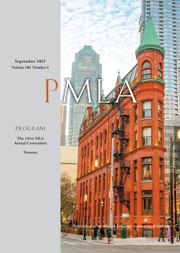No CrossRef data available.
Article contents
What Remains to Be Red
Published online by Cambridge University Press: 01 September 2025
Abstract
An abstract is not available for this content so a preview has been provided. Please use the Get access link above for information on how to access this content.
Information
- Type
- Theories and Methodologies
- Information
- Copyright
- © 2025 The Author(s). Published by Cambridge University Press on behalf of Modern Language Association of America
References
Works Cited
Baraka, Amiri. “The ‘Blues Aesthetic’ and the ‘Black Aesthetic’: Aesthetics as the Continuing Political History of a Culture.” Digging: The Afro-American Soul of American Classical Music, U of California P, 2009, pp. 19–27.Google Scholar
Benjamin, Walter. Selected Writings. Vol. 4, edited by Eiland, Howard and Michael, W. Jennings, Press, Belknap, 2006.Google Scholar
Davis, Angela. “Abolition Feminism: Theories and Practices for Our Time.” Eleventh Annual Nicos Poulantzas Memorial Lecture, 11 Dec. 2018, Poulantzas Institute, Athens, Greece.Google Scholar
Derrida, Jacques. “Toward an Ethic of Discussion.” Afterword. Translated by Samuel Weber. Limited Inc., edited by Graff, Gerald, Northwestern UP, 1988, pp. 111–60.Google Scholar
Dunayevskaya, Raya. “The Black Dimension in Women’s Liberation.” Women’s Liberation and the Dialectics of Revolution: Reaching for the Future, Humanities Press International, 1985, pp. 49–51.Google Scholar
Hartman, Saidiya. “The End of White Supremacy: An American Romance.” Bomb Magazine, 5 June 2020, bombmagazine.org/articles/2020/06/05/the-end-of-white-supremacy-an-american-romance/.Google Scholar
Moten, Fred. “Chromatic Saturation.” The Universal Machine, Duke UP, 2018, pp. 140–246.CrossRefGoogle Scholar
Sexton, Jared. “The Social Life of Social Death: On Afro-pessimism and Black Optimism.” InTensions, no. 5, 2011, https://doi.org/10.25071/1913-5874/37359.CrossRefGoogle Scholar
Sollers, Philippe, and Ponge, Francis. Entretiens de Francis Ponge avec Philippe Sollers. Gallimard, 1970.Google Scholar

